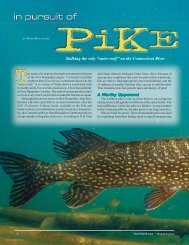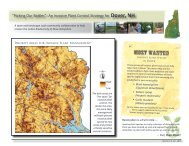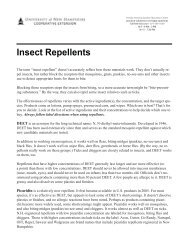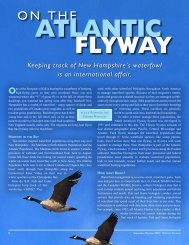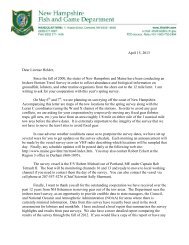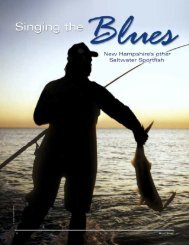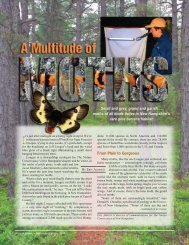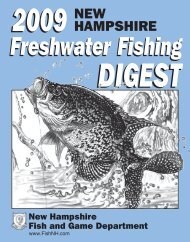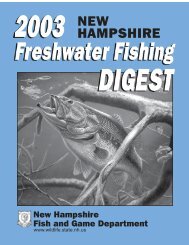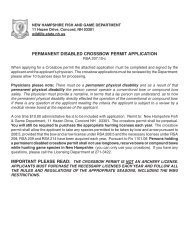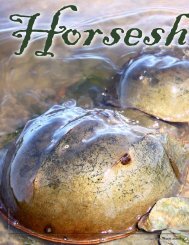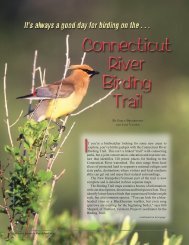Cod Spawning Protection Area - New Hampshire Fish and Game ...
Cod Spawning Protection Area - New Hampshire Fish and Game ...
Cod Spawning Protection Area - New Hampshire Fish and Game ...
- No tags were found...
You also want an ePaper? Increase the reach of your titles
YUMPU automatically turns print PDFs into web optimized ePapers that Google loves.
Lobster & CrabLobster GearLobsters shall only be taken by traps in state waters.Lobster Gear RequirementsVolumeEscape Vent Size(in parlor section)Escape Panels(in parlor section)Runners or SillsWeak LinksGroundlinesTrap <strong>and</strong> TrapTag LimitsNo more than 22,950 cubic inchesAt least 1 15 /16 inches x 5¾ inches or two circularvents at least 2 7 /16 inches in diameter; see otheroptions below• Hinged at the top of positively buoyant or bottom ofnegatively buoyant panels• Tied with an untreated natural fiber not to exceed3/16 inches in diameter OR nonstainless, uncoated,ferrous metal wire not exceeding 3 /32 inches indiameter• Opening must be at least 3¾ inches by 3¾ incheswhen open or removed• See further details belowMust have at least 2 running the length of the bottomof the trap600-pound breaking strength seaward of harbors(see Tide Table Pull-out Section–1)Sinking if seaward of the harbors (see Tide TablePull-out Section–1)• Depending on license type: recreational (5 traps),or commercial (100, 600, or 1200 traps)• Season runs June 1 – May 31• <strong>New</strong> tags must be affixed by June 1Escape vents or gapsMust be in the parlor section of the trap <strong>and</strong> may be:1. A rectangular or oblong escape vent at least 1 15 /16 inches by5¾ inches, located next to the bottom edge;2. Two circular vents at least 2 7 /16 inches in diameter;3. A gap created by raising, modifying or separating the horizontalor vertical laths so that they create openings as describedin 1) or 2) above;4. A gap caused by separating both ends of 2 laths 1¾ inches onthe top of the parlor section next to the middle bow or supportingframe <strong>and</strong> directly over the parlor head; or5. Vents cut in the side or the end of a wire or plastic trap thatcomply with the dimensions in 1) <strong>and</strong> 2) above.Biodegradable escape panels <strong>and</strong> runnersEach trap must have escape panels <strong>and</strong> at least two runners or sillsextending the entire length of the trap. Nothing may be placed inthe parlor section of the trap that will obstruct the opening afterdisintegration of the fiber. The traps must be constructed in thefollowing manner:• Rectangular wire or plastic mesh traps:1. Every trap must have at least 2 parallel runners or sillsattached to the bottom of the trap, running along the entirelength of the exterior.2. Every trap must have an unobstructed escape panel whichmust be:• Located in the parlor section on the sides or end;• Hinged at the top of positively buoyant panels or at thebottom of negatively buoyant panels;• Tied with an untreated natural fiber such as cotton, sisal,hemp or jute not exceeding 3 /16 inches in diameterbefore immersion in sea water, or a piece of nonstainless,uncoated ferrous metal wire not exceeding 3 /32 inches indiameter; <strong>and</strong>• Of sufficient size to create an opening of at least 3¾ inchesx 3¾ inches when the panel is removed or opened.• Non-rectangular wire or plastic mesh traps:Must have at least two runners <strong>and</strong> an escape panel which willcreate an opening of 3¾ inches x 3¾ inches when open. Theseconstruction designs must be approved in writing by the <strong>Fish</strong><strong>and</strong> <strong>Game</strong> Director.• Wood lath traps—half round, round or rectangular:Every trap must have at least two runners <strong>and</strong> an escape panel.An escape panel can be created by one untreated, softwoodlath running the full length of the parlor section. The lath musthave the same dimensions as the other laths on the trap. Itmust not be located where it will rest on the sea bottom. Afterdisintegration, it must leave a space of at least 3¾ inches x 3¾inches between the adjacent laths. One can also be created byan opening of at least 3 inches between adjacent laths, runningthe length of the parlor section, which is laced with an untreatednatural fiber such as cotton, sisal, hemp, or jute not exceeding3/16 inches in diameter before immersion in sea-water.Note: The <strong>Fish</strong> <strong>and</strong> <strong>Game</strong> Director may exempt specific trapdesigns from the escape vent <strong>and</strong> escape panel requirements if itcan be conclusively proven that the specific trap design will onlytake crabs <strong>and</strong> is incapable of catching lobster. Approval will begranted in writing only after inspection.Gear MarkingEach lobster or crab license holder has a color scheme or specialmarkings indicated on their license. These must be used to markall buoys. These colors must also be displayed on the boat, eitherby painting an area at least 1 square foot on the port <strong>and</strong> starboardside of the bow or by setting a painted buoy on the highest point ofthe boat (excluding the mast) visible for 360 degrees. The buoy orcolors must be permanently attached at all times while the lobsteror crab gear is being fished.Gear Marking RequirementsAll Fixed GearPot or Trap TrawlsLobster BuoyLobster TrapLobster CarLeave Lobster Pots Alone• Permanently marked with the owner’s name• Flags <strong>and</strong> pennants affixed to buoys marking astring of gear must be of uniform colorIf 5 or more traps or pots, must be marked withbuoys made of highly visible material set on bothends of the trawlLast name <strong>and</strong> initials, permanently marked (carvedor br<strong>and</strong>ed); 2 buoys per 5 or more trap trawlsLast name <strong>and</strong> initials, permanently marked(carved or br<strong>and</strong>ed)Last name <strong>and</strong> initials; permanently marked(carved or br<strong>and</strong>ed)Lobster pots, traps, warps (ropes), cars or buoys are private property,regardless of the location. This includes on the beach <strong>and</strong> inthe rocks. No person except the owner or a conservation officercan possess, lift, molest or disturb them. To do so can result in afine of $2,000 <strong>and</strong> up to 1 year in jail.Did You Know?If you have a lobster license, you are required to report catch <strong>and</strong>effort information. For more information, call Marine <strong>Fish</strong>eriesDivision at 603-868-1095.www.<strong>Fish</strong>NH.com 27



